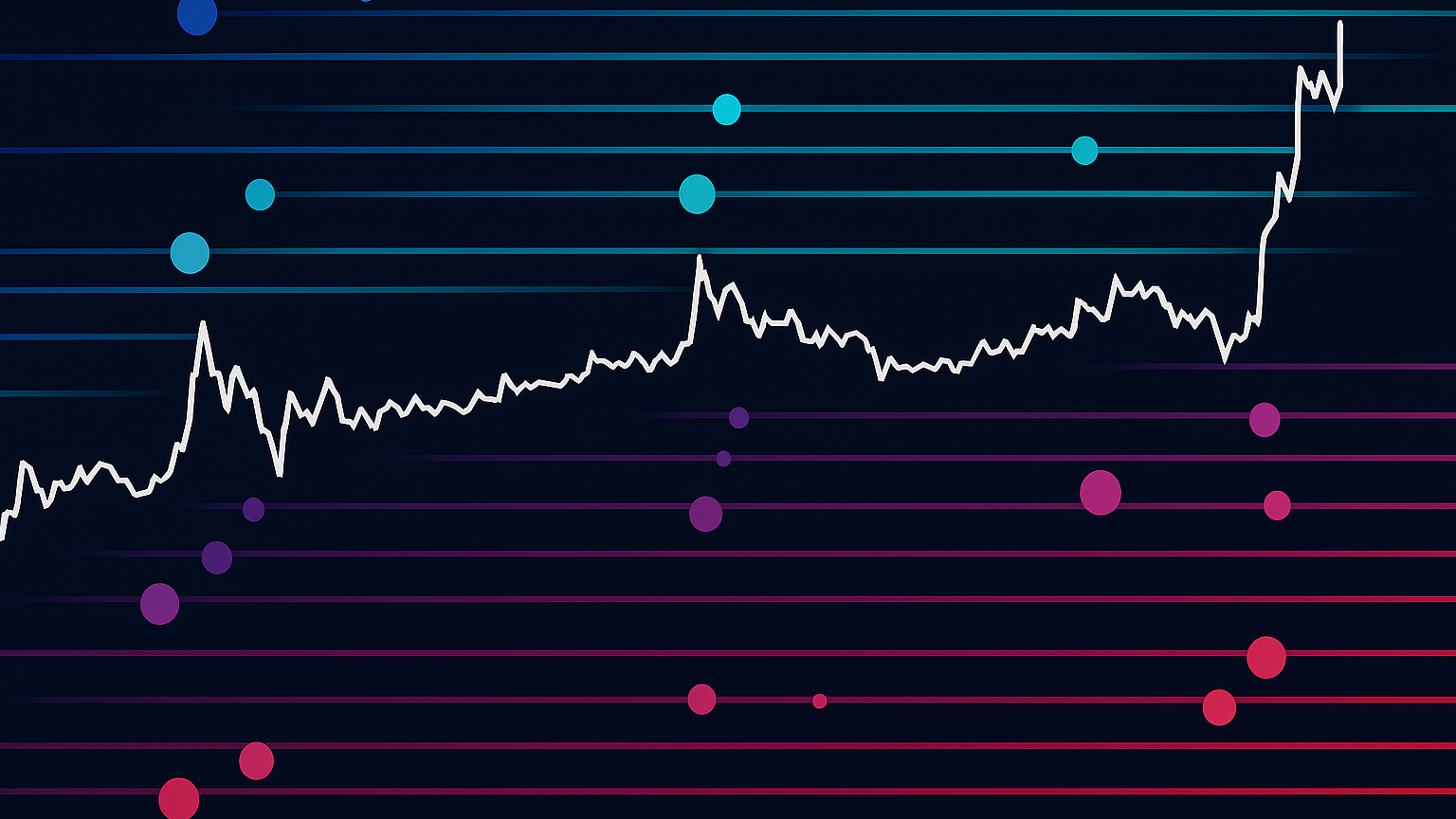Learn how to profit from neutral trading strategies in sideways markets using technical indicators, risk management, and options strategies.
Neutral trading is about making money when markets move sideways—without a clear trend. Here's how it works:
- Spot Sideways Markets: Look for prices bouncing between support and resistance levels, steady volume, and low volatility.
- Use Technical Indicators: Indicators like Bollinger Bands and RSI help confirm trading ranges.
- Trading Methods: Buy near support, sell near resistance, and use oscillators like RSI for precise entry signals.
- Risk Management: Protect yourself from false breakouts with tight stop-losses and small position sizes.
- Options Strategies: Use Iron Condors or Calendar Spreads to profit from low movement and time decay.
Sideways markets can last hours or weeks. With patience and the right approach, you can turn these phases into profit opportunities.
How to Spot Sideways Markets
Signs of a Sideways Market
Spotting a sideways market means recognizing specific price patterns and behaviors. The main clue? Prices move horizontally within a set range, with no clear dominance by buyers or sellers.
Here’s what to look out for:
| Characteristic | Description | Key Indicator |
|---|---|---|
| Price Action | Moves back and forth within set boundaries | No higher highs or lower lows |
| Volume | Stays steady and consistent | No major spikes in activity |
| News Impact | Minimal effect on price | Lower volatility |
These patterns are your starting point. From here, technical indicators can help confirm whether the market is range-bound.
Technical Indicators for Range Detection
Certain technical indicators can help confirm a sideways market:
- Bollinger Bands: The 20-day simple moving average (SMA) serves as the centerline, while the upper and lower bands at two standard deviations form the range. If prices consistently stay within these bands, it’s a strong sign of a sideways market (about 95% of movements).
- RSI (Relative Strength Index): Watch for the RSI to oscillate between 30 (oversold) and 70 (overbought), with prices often bouncing back from these levels.
"The RSI works best in trading ranges rather than trending markets." – Investopedia
These indicators help you zero in on key price levels, setting the stage for identifying support and resistance zones.
Finding Support and Resistance
Pinpointing support and resistance levels is critical when trading in a sideways market. Focus on recent price data, as it reflects the current market environment more accurately.
- Think in Zones: Treat support and resistance as areas, not fixed points. Price wicks might slightly breach these areas without invalidating them.
- Volume Matters: Look for volume spikes around potential zones—high activity often signals strong buying or selling interest.
- Quick Validation: Confirm levels quickly by spotting multiple touches that form a clear horizontal boundary.
"When a price zone gets the interest of the market, the market trades. And volume surges." – Galen Woods, Trading Setups Review
Bollinger Bands and RSI Trading Strategy Tutorial with Trade Examples
Trading Methods for Sideways Markets
Range Trading Basics
Range trading takes advantage of price movements between support and resistance levels. Buy near support when candlestick patterns and volume suggest buying pressure, and sell near resistance when selling signals emerge. This method works well across stocks, forex, and crypto.
Combine price action with volume analysis. As Fidelity notes: "Technical analysts tend to believe that volume precedes price; to confirm any trend, volume should increase in the direction of the trend."
Oscillator-Based Entry Points
In sideways markets, oscillators like RSI can provide reliable entry signals, especially when RSI narrows into the 40–60 range.
| Market Condition | RSI Range | Trading Approach |
|---|---|---|
| Trending | 30–70 | Use traditional overbought/oversold signals |
| Sideways | 40–60 | Focus on narrower-range signals |
| Confirmation | Multiple timeframes | Check smaller timeframes for precision |
Key entries:
- RSI near 40: Look for bullish patterns on shorter timeframes.
- RSI near 60: Watch for bearish patterns.
These signals pair well with MACD crossovers for extra confirmation.
Risk Control in Range Markets
False breakouts are common in sideways markets. To minimize losses:
- Set stop-losses at 1.5× the high-to-low range.
- Limit each position to 1% of total capital.
- Place stops just outside the established range.
"Every battle is won before it is fought." – Sun Tzu
Options Strategies for Flat Markets
Iron Condors and Credit Spreads
Iron Condors combine two credit spreads, allowing you to collect premiums when prices stay within a range. This strategy offers defined risk from both calls and puts, and profit potential from time decay.
| Component | Strike Selection | Purpose | Risk Profile |
|---|---|---|---|
| Short Call Spread | Above resistance | Collect premium | Defined risk |
| Short Put Spread | Below support | Collect premium | Defined risk |
| Total Position | 4 strikes total | Profit within range | Max loss defined |
For example, if SPY trades at $450 with support at $440 and resistance at $460, you could:
- Sell the 455/460 call spread
- Sell the 445/440 put spread
- Aim for a premium of 30–40% of the width between strikes
Calendar Spreads
Calendar spreads profit from time decay by selling near-term options and buying longer-term options at the same strike. Key considerations:
- Choose strikes close to current price for maximum theta.
- Watch implied-volatility differences between expirations.
- Plan to roll the front-month option with ~2 weeks to expiration.
Tools for Range Trading
When executing range strategies, precision matters. LuxAlgo provides hundreds of free indicators in its Library and three exclusive toolkits on TradingView—Price Action Concepts, Signals & Overlays, and Oscillator Matrix—that help you identify and trade within sideways markets.
LuxAlgo: Range Trading Indicator Kits
The PAC Toolkit automates support and resistance zones with market-structure analysis and volume-based order blocks. The S&O Toolkit adds overlay signals and advanced alerts. The Oscillator Matrix delivers money-flow insights for trend confirmation.
| Feature | Function | Benefit |
|---|---|---|
| PAC Backtester | Tests range strategies using price action | Confirms performance metrics |
| Oscillator Matrix | Detects real-time divergences | Highlights potential reversals |
| Fibonacci Ranges | Creates channels based on Fibonacci ratios | Establishes clear ranges |
Strategy Automation
LuxAlgo simplifies strategy creation with its AI Backtesting platform. It automates entry rules, exit conditions, and position sizing based on market volatility, accounting for commissions, slippage, and realistic order execution.
Trading Communities
Join the active LuxAlgo community for range-trading insights:
- Share range strategies
- Get real-time market ideas
- Develop and backtest custom setups
- Collaborate on improving performance
Plans start at $0 for the free Library. Essential is $24.99/mo for PAC Toolkit & screener, Premium is $39.99/mo to add S&O and Oscillator Matrix, and Ultimate is $59.99/mo for the AI Backtesting platform.
Conclusion
To navigate sideways markets effectively, focus on precise market recognition, technical expertise, and disciplined risk management. Range conditions can persist for hours or weeks, requiring strategies different from trending markets.
- Indicator-Driven Analysis: Identify support and resistance with Bollinger Bands and oscillators.
- Adaptive Strategies: Use simple price-action trades or advanced options like Iron Condors.
- Strict Risk Controls: Employ tight stop-losses, small position sizes, and clear exit rules.
With the right indicators and a disciplined approach, range trading can become a reliable addition to your toolkit.







